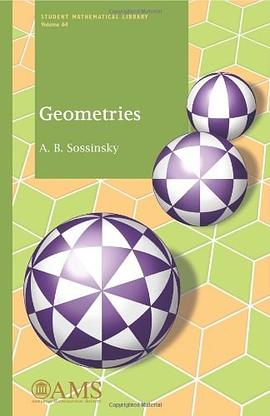Geometries
豆瓣
A. B. Sossinsky
简介
The book is an innovative modern exposition of geometry, or rather, of geometries; it is the first textbook in which Felix Klein's Erlangen Program (the action of transformation groups) is systematically used as the basis for defining various geometries. The course of study presented is dedicated to the proposition that all geometries are created equal—although some, of course, remain more equal than others. The author concentrates on several of the more distinguished and beautiful ones, which include what he terms “toy geometries”, the geometries of Platonic bodies, discrete geometries, and classical continuous geometries.
The text is based on first-year semester course lectures delivered at the Independent University of Moscow in 2003 and 2006. It is by no means a formal algebraic or analytic treatment of geometric topics, but rather, a highly visual exposition containing upwards of 200 illustrations. The reader is expected to possess a familiarity with elementary Euclidean geometry, albeit those lacking this knowledge may refer to a compendium in Chapter 0. Per the author's predilection, the book contains very little regarding the axiomatic approach to geometry (save for a single chapter on the history of non-Euclidean geometry), but two Appendices provide a detailed treatment of Euclid's and Hilbert's axiomatics. Perhaps the most important aspect of this course is the problems, which appear at the end of each chapter and are supplemented with answers at the conclusion of the text. By analyzing and solving these problems, the reader will become capable of thinking and working geometrically, much more so than by simply learning the theory.
Ultimately, the author makes the distinction between concrete mathematical objects called “geometries” and the singular “geometry”, which he understands as a way of thinking about mathematics. Although the book does not address branches of mathematics and mathematical physics such as Riemannian and Kähler manifolds or, say, differentiable manifolds and conformal field theories, the ideology of category language and transformation groups on which the book is based prepares the reader for the study of, and eventually, research in these important and rapidly developing areas of contemporary mathematics.
contents
Cover 1
Title page 4
Contents 6
Preface 14
About Euclidean geometry 18
Toy geometries and main definitions 50
Abstract groups and group presentations 70
Finite subgroups of 𝑆𝑂(3) and the platonic bodies 84
Discrete subgroups of the isometry group of the plane and tilings 102
Reflection groups and Coxeter geometries 116
Spherical geometry 126
The Poincaré disk model of hyperbolic geometry 142
The Poincaré half-plane model 160
The Cayley-Klein model 170
Hyperbolic trigonometry and absolute constants 180
History of non-Euclidean geometry 194
Projective geometry 202
“Projective geometry is all geometry” 220
Finite geometries 228
The hierarchy of geometries 246
Morphisms of geometries 258
Excerpts from Euclid’s “Elements” 272
Hilbert’s axioms for plane geometry 288
Answers & hints 300
Bibliography 314
Index 316
Back Cover 322